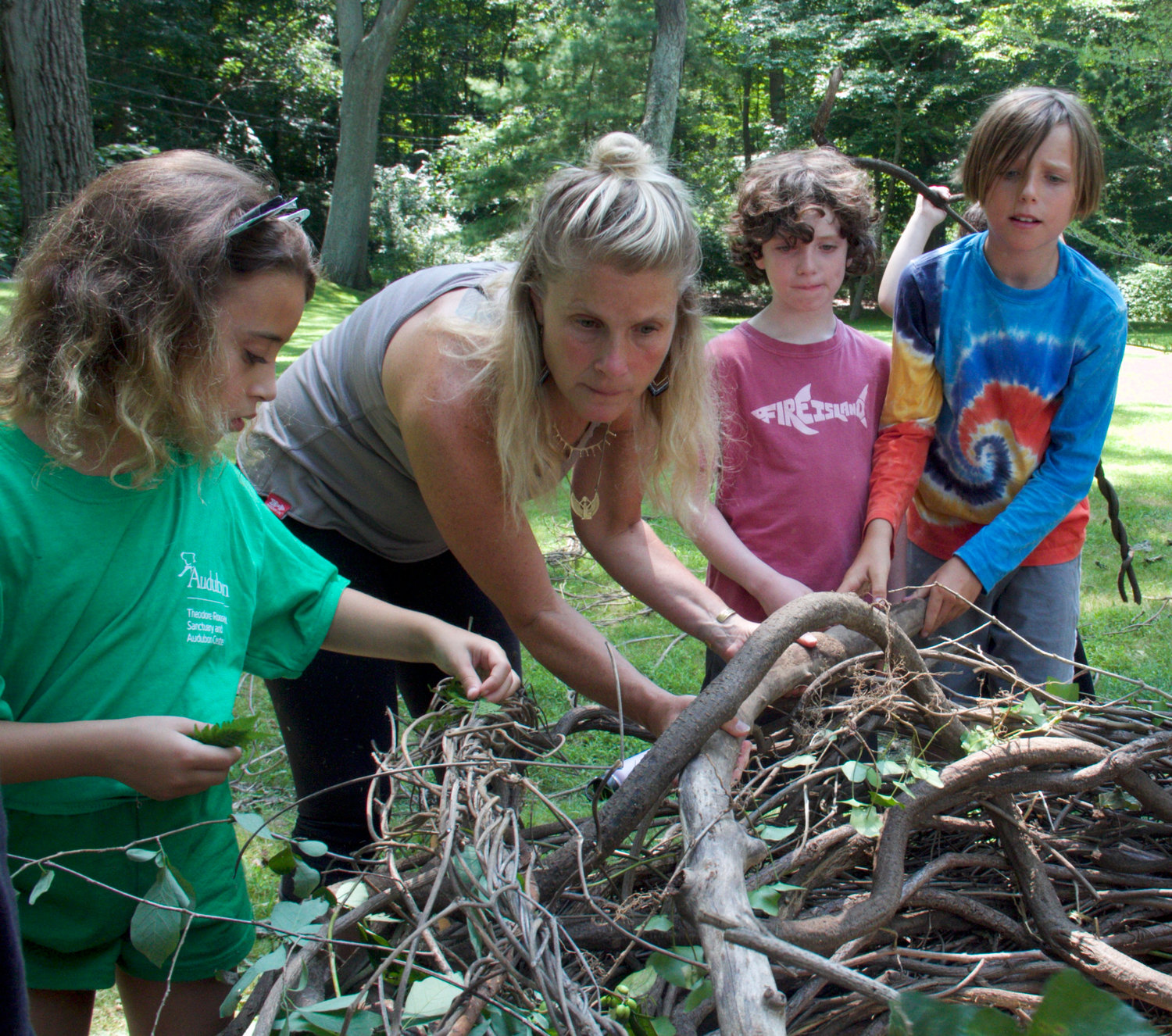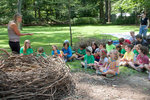Back to the nest — artist pays a visit to Theodore Roosevelt Sanctuary
Artist Debbie Baxter dropped by the Theodore Roosevelt Sanctuary and Audubon Center this summer to gather twigs and vines for one of her signature human-scale nests due to be installed at a hotel in Manhattan. She was assisted in July by 32 of the center’s young campers, who also learned all about the unique project.
The presentation came after Baxter, an Ohio-born artist based in Portland, Oregon, had spent the morning gathering vinca and English Ivy vines from the premises, to supplement the thicker grape vines and straw she had already culled from locations in Washington D.C. Baxter told the children that she was assembling a human-sized nest for a one-day installation at the Ace Hotel in Manhattan.
Kathryn D’Amico, the sanctuary’s manager, said that last year the center had an artist who was a mother of one of the campers teach the children nature sketching. But Baxter’s visit was the first time an artist from the outside shared their talents with the campers.
“Nature and art collaborations go hand in hand,” D’Amico said. “Capturing nature through art is critical. A lot of the kids are artistic and make connections that way.”
The installation at the Ace Hotel was curated by Ace New York & Hatchers — a storytelling container sponsored by the New York Foundation for the Arts — as part of a broader series of activities in Manhattan that involve artists and creators working in music, art, dance, and more, to share ‘the joy and terror of expressing yourself and finding community through creativity.’
Baxter, along with special guests Elana Ball and Bernadette Pleasant, led audience members on what was described as a journey back to home through the stunning images of nest portraits, an installation of a human sized nest and a primal dance performance.
Baxter has been building human-scale nests for about three years and has installed them everywhere in the western part of the United States from Seattle and Portland to Hawaii and Burning Man. More locally, her nests have appeared in such locations as Boston and at the Wyckoff Bond Community Garden in Brooklyn.
“That one was great,” she recalled. “I think 35 people got in the nest. We got a page two writeup in the New York Post for that.”
Got in the nest?
Exactly. It seems that climbing into the artwork is a fundamental aspect of the artform itself, for children and adults. Moreover, having their photographs taken in the nest by Baxter is often part of the experience. Not just selfies, but posed by the artist behind a curtain, reflecting a kind of return to the womb on the part of the individual who agrees to participate.
“It is a moving human experience,” says Baxter. “Both to get in the nest, and to view these images.”
Central to the concept, according to the artist, is that “returning to the nest” is a way for people who have experienced some trauma in their life to “go back to nature, go back to the womb” in the form of the nest.
D’Amico said that an Audubon member in Connecticut had recommended that Baxter create the nest either at a location in Westchester or at the Theodore Roosevelt Sanctuary and Audubon Center. She said she is glad Baxter chose the center.
“This is one of the many ways we make connections to artists,” D’Amico said. “We have art and photo exhibits, and we are visited on almost a daily basis by artists and photographers. We are happy to have the artist make use of our vines, glad to get rid of them.”
And, DiAmico said, they are looking forward to the nest coming back to the center. “We will have the nest on hand, possibly for years,” she said, “so kids visiting our center can get in it and discover how it looks and feels to be in a human-scale nest.”
-Laura Lane contributed to this article.

 45.0°,
Mostly Cloudy
45.0°,
Mostly Cloudy 







